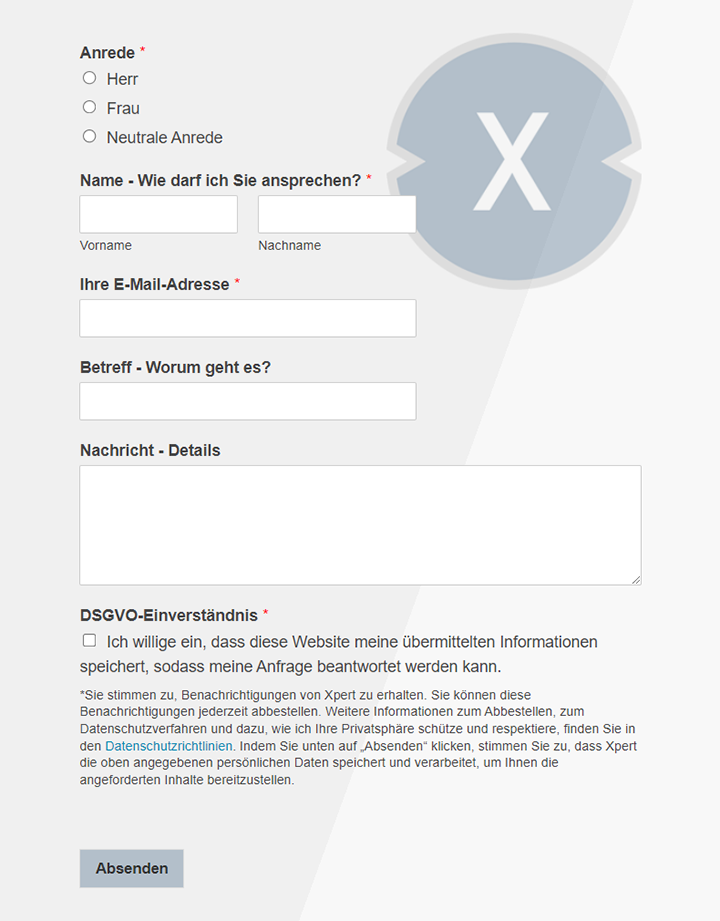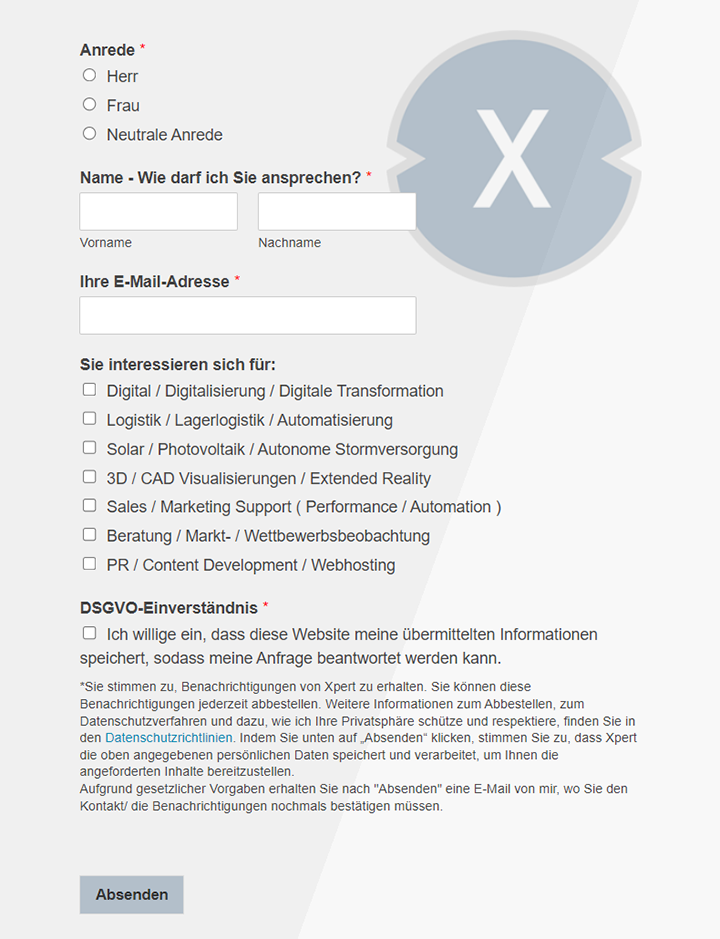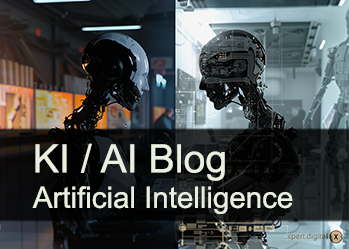Metas brain2qwerty with the Meta AI: a milestone in the non-invasive brain-to-text decoding
Xpert pre-release
Language selection 📢
Published on: February 16, 2025 / update from: 16. February 2025 - Author: Konrad Wolfenstein

Metas brain2qwerty with the Meta AI: a milestone in the non-invasive brain-to-text decoding-Image: Xpert.digital
Meta ai 'reads' Thoughts?: The breakthrough of brain-to-text technology
Forget Type! Meta Ai decodes your thoughts directly in text - the future of communication
The development of brain2qwerty through Meta AI represents significant progress in the area of brain computer interfaces (BCIS). By using magnetoencephalography (MEG) and electroencephalography (EEG), this system succeeds in converting brain signals into text, whereby under optimal Conditions are achieved a sign of up to 81 %. Even if the technology is not yet ready for the market, it already shows great potential, especially for people with language or movement disorders who are looking for new communication channels.
The development of the brain computer interfaces
Historical background and medical needs
Brain computer interfaces were developed to create direct communication channels between the human brain and external devices. While invasive methods with implanted electrodes already offer high accuracy of over 90 %, they are associated with considerable risks, including infections and the need for surgical interventions. Non-invasive alternatives such as EEG and MEG are considered safer, but have so far had to struggle with limited signal quality. Brain2qwerty from Meta Ai tries to close this gap by reaching an error rate of only 19 % for MEG-based decoding for the first time.
EEG vs. MEG: Advantages and disadvantages of the measurement methods
EEG measures electrical fields on the scalp by electrodes, while MEG records magnetic fields of neuronal activity. MEG offers a much higher spatial resolution and is less susceptible to signal distortions. This explains why Brain2qwerty with MEG achieves a drawing error rate of only 32 %, while EEG-based systems have a 67 % error rate. However, MEG devices with prices of up to two million US dollars and a weight of 500 kg are difficult to access and are currently not suitable for broad use.
Architecture and functionality of brain2qwerty
Three -stage model for signal processing
Brain2qwerty relies on a combination of three modules:
- Convolutional module: Extracts spatial-temporal characteristics from raw data from MEG/EEG and identifies patterns that are related to motor impulses when typing.
- Transformer module: analyzes brain signals sequentially in order to record context information and thus enables the prediction of entire words instead of individual characters.
- Language module: A pre -trained neuronal network corrects errors based on linguistic probabilities. For example, “HLL@” is completed by contextual knowledge to “Hello”.
Training process and adaptability
The system was trained with data from 35 healthy subjects who spent 20 hours in the MEG scanner for 20 hours. They repeatedly typed sentences like “ el procesador ejecuta la instrucción ”. The system learned to identify specific neural signatures for every keyboard sign. Interestingly, Brain2qwerty was also able to correct typing errors, which indicates that it integrates cognitive processes.
Performance evaluation and comparison with existing systems
Quantitative results
In tests, Brain2qwerty with MEG reached an average character error rate of 32 %, with some subjects even getting 19 %. For comparison: Professional human transcripters achieve an error rate of around 8 %, while invasive systems such as neuralink are below 5 %. EEG-based decoding was significantly worse with 67 % error rate.
Qualitative progress
In contrast to previous BCIs that used external stimuli or imagined movements, Brain2qwerty relies on natural motor processes when tapping. This reduces the cognitive effort of the users and for the first time enables the decoding of entire sentences from non-invasive brain signals.
From thoughts to text: overcome the hurdles of generalization
Technical limits
Current problems include:
- Real -time processing: Brain2qwerty can currently only decode after completing a sentence, not signs.
- Device portability: Current MEG scanner are too bulky for everyday use.
- Generalization: The system was only tested with healthy subjects. It remains unclear whether it works in patients with motor restrictions.
Brain2qwerty: revolution or risk? Metas brain interface in the data protection check
The possibility of reading brain signals raises serious data protection questions. Meta emphasizes that Brain2qwerty only captures intended tip movements, no unconscious thoughts. In addition, there are currently no commercial plans, but primarily scientific use to research neuronal language processing.
Future perspectives and possible applications
Transfer learning and hardware optimizations
Meta researches transfer learning to transfer models to different users. The first tests show that a KI trained for person A can also be used for person B by fine -tuning. In parallel, researchers work on portable MEG systems that are cheaper and more compact.
Integration with language CIS
In the long term, the Brain2qwerty encoder could be combined with voice models such as GPT-4. This would enable the decoding of complex content by converting brain signals directly into semantic representations.
Clinical applications
For patients with locked-in syndrome or as if Brain2qwerty could offer revolutionary communication options. To do this, however, motor -independent signals such as visual ideas would have to be integrated into the system.
Future trend: Thought -controlled communication thanks to AI and innovative hardware
Metas brain2qwerty impressively shows that non-invasive BCIs can be significantly improved by deep learning. Although the technology is still in the development phase, it paves the way for safe communication aids. Future research must close the gap into invasive systems and define ethical framework conditions. With further advances in hardware and AI, the vision of a thought -controlled communication could soon become a reality.
Our recommendation: 🌍 Limitless reach 🔗 Networked 🌐 Multilingual 💪 Strong sales: 💡 Authentic with strategy 🚀 Innovation meets 🧠 Intuition
At a time when a company's digital presence determines its success, the challenge is how to make this presence authentic, individual and far-reaching. Xpert.Digital offers an innovative solution that positions itself as an intersection between an industry hub, a blog and a brand ambassador. It combines the advantages of communication and sales channels in a single platform and enables publication in 18 different languages. The cooperation with partner portals and the possibility of publishing articles on Google News and a press distribution list with around 8,000 journalists and readers maximize the reach and visibility of the content. This represents an essential factor in external sales & marketing (SMarketing).
More about it here:
The brain as a keyboard: Meta ai's brain2qwerty changes everything - what does that mean for us? - Background analysis
Metas brain2qwerty with Meta AI: a milestone in the non-invasive brain-to-text decoding
The development of Brain2qwerty through Meta AI is a significant breakthrough in the research field of non-invasive brain computer interfaces (BCIS). This innovative system uses magnetoencephalography (MEG) and electroencephalography (EEG) to transform neural signals into written text . Under optimal conditions, it achieves a remarkable precision of up to 81 % at the sign level. Although this technology is not yet ready for everyday use, it impressively demonstrates the long-term potential of opening up a completely new form of communication. This progress could fundamentally change the life of millions of people worldwide and the way we think about communication and technology.
Basics of the brain computer interfaces: a journey through science
Historical roots and the urgent need for clinical applications
The idea of creating a direct connection between the human brain and external devices is not new, but is rooted in decades of research and innovation. Brain computer interfaces, or BCIs for short, are systems that aim to establish this direct communication path. The first concepts and experiments in this area go back to the 20th century, as scientists began to examine the electrical activities of the brain more closely.
Invasive BCI methods, in which electrodes are implanted directly into the brain, have already achieved impressive results and, in some cases, have achieved accuracy of over 90 %. These systems have shown that it is possible to decode complex motor commands and, for example, to control prostheses or computer cursor via thought power. Despite these successes, invasive methods are associated with considerable risks. Surgical interventions on the brain always pose the risk of infections, tissue damage or long -term complications from the implanted hardware. In addition, the long -term stability of the implants and their interaction with the brain tissue is an ongoing challenge.
Non-invasive alternatives such as EEG and MEG offer a significantly more secure method because they do not require surgery. At the EEG, electrodes are placed on the scalp to measure electrical fields, while MEG captures magnetic fields that arise from neural activity. In the past, however, these methods have often failed due to lower signal quality and the associated lower decoding accuracy. The challenge was to extract enough information from the relatively weak and noisy signals measured from outside the skull to enable reliable communication.
Meta Ai addressed exactly this gap with Brain2qwerty. By using advanced algorithms of mechanical learning and the combination of EEG and MEG data, they have succeeded in demonstrating an error rate of only 19 % in the MEG-based decoding. This is a significant progress and approaches non-invasive BCIs closer to a practical application. The development of Brain2qwerty is not only a technical success, but also a glimmer of hope for people who have lost their ability to speak as or other diseases due to paralysis, strokes, or other diseases. For these people, a reliable brain-to-text interface could mean a revolution in their quality of life and allow them to actively participate in social life again.
Technological differences in detail: EEG versus MEG
In order to fully understand the performance of Brain2qwerty and the progress that it represents, it is important to take a closer look at the technological differences between EEG and MEG. Both methods have their specific advantages and disadvantages that influence their applicability for different BCI applications.
Electroencephalography (EEG) is an established and widespread method in neuroscience and clinical diagnostics. It measures the electrical potential fluctuations caused by the collective activity of neuron groups in the brain. These fluctuations are recorded via electrodes, which are usually attached to the scalp. EEG systems are comparatively inexpensive, mobile and easy to use. They offer a high time resolution in the millisecond range, which means that quick changes in brain activity can be precisely recorded. However, EEG has a limited spatial resolution. The electrical signals are distorted and smeared when passing through the skull and scalp, which makes it difficult to locate the exact location of the neuronal sources of activity. Typically, the spatial resolution of EEG is in the range of 10-20 millimeters or more.
The magnetoencephalography (MEG), on the other hand, measures the magnetic fields that are generated by neural currents. In contrast to electrical fields, magnetic fields are less influenced by the tissue of the skull. This leads to a significantly higher spatial resolution of MEG, which is in the millimeter range (approx. 2-3 mm). MEG therefore makes it possible to locate neural activity more precisely and to recognize finer differences in the activity of different brain areas. In addition, MEG also offers a very good time resolution, comparable to EEG. Another advantage of MEG is that it can better capture certain types of neuronal activity than EEG, in particular activity in lower brain regions and tangential -oriented currents.
The main disadvantage of MEG is the elaborate and expensive technology. MEG systems require super-conducting quantum interferometers (squids) as sensors that are extremely sensitive to magnetic fields. These squids must be cooled at extremely low temperatures (near the absolute zero point), which makes the operation and maintenance of the devices complex and expensive. In addition, MEG measurements must be carried out in magnetically shielded rooms in order to minimize disorders from external magnetic fields. These rooms are also expensive and complex to install. A typical MEG device can cost up to $ 2 million and weighs about 500 kg. These factors consider the spread of MEG technology considerably.
The significant increase in performance of Brain2qwerty with MEG compared to EEG (32 % character error rate vs. 67 %) underlines the advantages of the higher signal quality and spatial resolution of MEG for demanding decoding tasks. Although EEG is a much more accessible technology, MEG shows that there is still considerable potential in non-invasive BCI research with more precise measurement methods and sophisticated algorithms. Future developments could aim to reduce the costs and complexity of MEG or to develop alternative, cheaper methods that offer similar advantages in terms of signal quality and spatial resolution.
Architecture and functionality of Brain2qwerty: A look under the hood
The three-stage model of signal processing: From the brain signal to the text
Brain2qwerty uses a sophisticated three -stage model to translate the complex neuronal signals into readable text. This model combines the most modern techniques of mechanical learning and neural networks to cope with the challenges of non-invasive brain-to-text decoding.
Convolution module
The extraction of spatial-time features: The first module in the pipeline is a convolution neuronal network (CNN). CNNs are particularly good at recognizing patterns in spatial and temporal data. In this case, the CNN analyzes the raw data that of MEG or EEG-
Sensors are recorded. It extracts specific spatial-time features that are relevant for decoding tip movements. This module is trained to identify repetitive patterns in the brain signals that correlate with the subtle motor impulses when typing on a virtual keyboard. In a way, it filters the “noise” out of the brain signals and focuses on the informative shares. The CNN learns which brain regions are active in certain tip movements and how this activity develops in time. It identifies characteristic patterns that make it possible to distinguish different keyboard attacks.
Transformer module
Understand the context and analyze sequences: The second module is a transformer network. Transformers have proven to be revolutionary in the processing of sequential data, especially in natural language processing. In the context of Brain2qwerty, the transformer module analyzes the sequences of brain signals that were extracted by the convolution module. The key to the success of Transformer networks lies in your “Attention” mechanism. This mechanism enables the network to grasp relationships and dependencies between different elements in a sequence - in this case between successive brain signals that represent different letters or words. The transformer module understands the context of the input and can thus make predictions about the next sign or word. It learns that certain letter combinations are more likely than others and that words are in a sentence in a certain grammatical and semantic relationship with each other. This ability to model context is crucial in order not only to decode individual characters, but to understand and generate entire sentences.
Voice module
Error correction and linguistic intelligence: The third and last module is a pre -trained neuronal voice model. This module specializes in refining and correcting the text sequences generated by the Transformer module. Language models such as GPT-2 or Bert, which can be used in such systems, have been trained on huge amounts of text data and have a comprehensive knowledge of language, grammar, style and semantic relationships. The language module uses this knowledge to correct mistakes that could have been created in the previous decoding steps. If, for example, the system outputs “hello” instead of “hello” due to signal noise or decoding vacations, the language module can recognize this and correct it with the help of linguistic probabilities and context knowledge in “Hello”. The voice module thus acts as a kind of “intelligent corrector” that converts the raw editions of the previous modules into coherent and grammatically correct text. It not only improves the accuracy of decoding, but also the readability and naturalness of the generated text.
Training data and the art of adaptability: learning from tapping
Extensive data was required to train Brain2qwerty and develop its performance. Meta AI carried out a study with 35 healthy subjects. Each subject spent about 20 hours in the MEG scanner while typing various sentences. The sentences were in different languages, including Spanish (“El Procesador Ejecuta la Instrucción” - “The processor shows the instruction”) to demonstrate the versatility of the system.
During the tip, the test subjects' brain activities were recorded with MEG. The AI analyzed this data in order to identify specific neuronal signatures for each individual keyboard sign. The system learned which pattern of brain activity corresponds to typing the letter “A”, “B”, “C” etc. The more data the system received, the more precisely it became the detection of these patterns. It is comparable to learning a new language: the more you practice and the more examples you see, the better you get in it.
An interesting aspect of the study was that Brain2qwerty not only learned the correct tip entries, but also recognized and even corrected typing errors of the test subjects. This indicates that the system not only captures purely motor processes, but also to type cognitive processes such as intention and expectation of a specific word or sentence. If, for example, a subject types “accidentally” “Fhelr”, but actually wanted to write “errors”, the system could recognize this and correct the error, even if the subject of the subjects reflected the typing error. This ability to corrective error at the cognitive level is a sign of the advanced intelligence and adaptability of Brain2qwerty.
The amount of training data per person was considerable: each subject typed several thousand characters during the study. This large amount of data made it possible for the AI to learn robust and reliable models that work well even with new, unknown inputs. In addition, the system's ability to adapt to individual tip styles and neuronal signatures demonstrates the potential for personalized BCI systems that are tailored to the specific needs and properties of individual users.
Performance evaluation and comparison: Where is Brain2qwerty in competition?
Quantitative results: character error rate as a yardstick
The performance of Brain2qwerty was measured quantitatively based on the drawing error rate (CER - Character Error Rate). The CER indicates which percentage of the decoded characters is wrong compared to the actually typed text. A lower CER means greater accuracy.
In the tests, Brain2qwerty with MEG reached an average CER of 32 %. This means that an average of about 32 out of 100 decoded characters were wrong. The best subjects even reached a 19 % CER, which represents a very impressive performance for a non-invasive BCI system.
For comparison: Professional human transcriptionists usually reach a CER of around 8 %. Invasive BCI systems, in which electrodes are implanted directly into the brain, can achieve even lower error rates of less than 5 %. EEG-based decoding with Brain2qwerty was 67 %, which underlines the clear superiority of MEG for this application, but also shows that EEG does not yet achieve the same precision in this specific implementation.
It is important to note that the CER of 19 % was reached under optimal conditions, i.e. in a controlled laboratory environment with trained subjects and high-quality MEG equipment. In real application scenarios, especially in patients with neurological diseases or under less ideal measurement conditions, the actual error rate could be higher. Nevertheless, the results of Brain2qwerty are a significant progress and show that non-invasive BCIs are increasingly approaching invasive systems in terms of accuracy and reliability.
Qualitative progress: naturalness and intuitive operation
In addition to the quantitative improvements in accuracy, Brain2qwerty also represents qualitative progress in BCI research. Earlier BCI systems were often based on external stimuli or imagined movements. For example, users had to imagine moving a cursor on a screen or paying attention to flashing lights to give commands. These methods can be cognitively exhausting and not very intuitive.
Brain2qwerty, on the other hand, uses natural motor processes when typing. It decodes the brain signals that are connected to the actual or intended movements when typing on a virtual keyboard. This makes the system more intuitive and reduces the cognitive effort for users. It feels more natural to imagine, typing, solving mental tasks as abstract to control a BCI.
Another important qualitative progress is Brain2qwerty's ability to decode complete sentences from brain signals that were measured outside the skull. Earlier non-invasive BCI systems were often limited to decoding individual words or short phrases. The ability to understand and generate entire sentences opens up new opportunities for communication and interaction with technology. It enables more natural and fluid conversations and interactions instead of laboriously assembling individual words or commands.
Challenges and ethical implications: the way to responsible innovation
Technical limitations: hurdles on the way to practical suitability
Despite Brain2qwerty's impressive progress, there are still a number of technical challenges that have to be mastered before this technology can be used in practice.
Real -time processing
Brain2qwerty text is currently only decoding after completing a sentence, not in real time signs for characters. However, real-time decoding is essential for natural and liquid communication. Ideally, users should be able to convert their thoughts into text while they think or tap, similar to normal typing on a keyboard. Improving processing speed and reducing the latency time are therefore important goals for future developments.
Device portability
MEG scanners are large, heavy and expensive devices that need magnetic shielded rooms. They are not suitable for home use or for use outside of specialized laboratory environments. Portable, wireless and cheaper devices are required for broad use of BCI technology. The development of more compact MEG systems or the improvement of the signal quality and decoding accuracy of EEG, which is naturally more portable, are important research directions.
Generalization and patient populations
The study with Brain2qwerty was carried out with healthy subjects. It is still unclear whether and how well the system works in patients with paralysis, language disorders or neurodegenerative diseases. These patient groups often have changed brain activity patterns that can make decoding difficult. It is important to test and adapt Brain2qwerty and similar systems to various patient populations in order to ensure their effectiveness and applicability for people who need the most urgent.
Ethical questions: data protection, privacy and the limits of reading reading
The ability to convert thoughts into text raises profound ethical questions, especially with regard to data protection and privacy. The idea that technology could potentially “read” is worrying and requires careful examination of the ethical implications.
Meta Ai emphasizes that Brain2qwerty currently only captures intended tip movements and no spontaneous thoughts or involuntary cognitive processes. The system is trained to recognize neural signatures that are associated with the conscious attempt to tap on a virtual keyboard. It is not designed to decode general thoughts or emotions.
Nevertheless, the question remains where the border between the decoding of intended actions and the “reading” of thoughts runs. With progressive technology and improved decoding accuracy, future BCI systems could possibly be able to capture increasingly subtle and more complex cognitive processes. This could consider considering privacy, especially if such technologies are used commercially or are integrated into everyday life.
It is important to create ethical framework conditions and clear guidelines for the development and application of BCI technology. This includes questions of data protection, data security, consent after clarification and protection against abuse. It must be ensured that the privacy and autonomy of users are respected and that BCI technology is used for the well-being of people and society.
Meta AI has emphasized that their research on Brain2qwerty primarily serves to understand neuronal language processing and currently have no commercial plans for the system. This statement underlines the need that research and development in the field of BCI technology are guided by ethical considerations from the start and that the potential social effects are carefully weighed up.
Future developments and potential: visions for a thought -controlled future
Transfer learning and hardware innovations: acceleration of progress
Research on Brain2qwerty and related BCI systems is a dynamic and quickly developing field. There are a number of promising research directions that have the potential to further improve the performance and applicability of non-invasive BCIs in the future.
Transfer
Meta AI researches transfer learning techniques to transmit trained models between different subjects. Brain2qwerty currently has to be trained individually for each person, which is time -consuming and resource -intensive. Transfer learning could enable a model that was trained for one person to use as the basis for training a model for another person. The first tests show that a KI trained for person A can also be used for person B by fine -tuning. This would significantly reduce the training effort and accelerate the development of personalized BCI systems.
Hardware innovations
In parallel to software development, researchers are working on improving the hardware for non-invasive BCIs. An important focus is on the development of portable MEG systems that are wireless and cheaper. There are promising approaches that are based on new sensor technologies and cryo cooling methods that could potentially enable smaller, lighter and less energy-intensive MEG devices. There is also progress in the EEG area in the development of high -density electrode arrays and improved signal processing, which are intended to improve the signal quality and spatial resolution of EEG.
Integration with language CIS: The next generation of decoding
In the long term, the combination of brain-to-text decoding with advanced voice models such as GPT-4 or similar architectures could lead to even more powerful and versatile BCI systems. The encoder of Brain2qwerty, which converts brain signals into a textual representation, could be merged with the generative skills of voice models.
This would enable decoding of unknown sentences and more complex thoughts. Instead of just decoding tip movements, future systems could translate brain signals directly into semantic representations, which could then be used by a voice model to generate coherent and sensible answers or texts. This integration could continue to blur the limit between the brain computer interfaces and artificial intelligence and lead to completely new forms of human-computer interaction.
Clinical applications: Hope for people with communication barriers
For patients with locked-in syndrome, as or other serious neurological diseases, Brain2qwerty and similar technologies could be life-changing communication aid. For people who are completely paralyzed and have lost their ability to speak or have become conventional, a reliable brain-to-text interface could be a way to express their thoughts and needs and interact with the outside world.
However, the current version of Brain2qwerty, which is dependent on tip movements, must be further developed in order to integrate motor -independent signals. Systems based on other forms of neuronal activity are required for fully paralyzed patients, for example to speak to visual imagination, mental imagination or intention, without actual motor design. Research in this area is crucial to make BCI technology accessible to a wider spectrum of patients.
Metas brain2qwerty has shown that non-invasive BCIs can be significantly improved by using deep learning and advanced signal processing. Although the technology is still in the laboratory stage and there are still many challenges to be overcome, it paves the way for safer, more accessible and more user -friendly communication aids. Future research must further close the gap to invasive systems, clarify the ethical framework and adapt the technology to the needs of different user groups. With further advances in hardware, AI models and our understanding of the brain, the vision of thought-controlled communication could become a reality in the not too distant future and change the life of millions of people worldwide.
Neuronal decoding and text generation: The functionality of modern brain transcription systems in detail
The ability to translate brain signals directly into text is a fascinating and promising research field at the interface of neurosciences, artificial intelligence and computer technology. Modern brain transcription systems, such as Metas Brain2qwerty, are based on a complex multi-stage process that combines neuroscientific knowledge about the organization and function of the brain with sophisticated deep learning architectures. The focus is on the interpretation of neuronal activity patterns, which correlate with linguistic, motor or cognitive processes. This technology has the potential to play a transforming role in medical applications, for example as a communication aid for people with paralysis, as well as in technological applications, for example as a new human-computer interface.
Basic principles of signal recording and processing: The bridge between the brain and computer
Non-invasive measurement techniques: EEG and MEG in comparison
Modern brain transcription systems primarily rely on two non-invasive methods for measuring brain activity: electroencephalography (EEG) and magnetoencephalography (MEG). Both techniques enable neuronal signals from outside of the skull without being required to surgery.
Electroencephalography (EEG)
EEG is an established neurophysiological method that measures electrical potential changes on the scalp. These potential changes arise from the synchronized activity of large neuron groups in the brain. In the case of an EEG measurement, up to 256 electrodes are placed on the scalp, typically in a standardized arrangement that covers the entire head area. EEG systems record the voltage differences between the electrodes and thus create an electroencephalogram that reflects the time dynamics of brain activity. EEG is characterized by a high temporal resolution of up to 1 millisecond, which means that very fast changes in brain activity can be precisely recorded. However, EEG's spatial resolution is limited and is typically in the range of 10-20 millimeters. This is due to the fact that the electrical signals are distorted and smeared spatially when passed by skull bones, scalp and other tissue layers. EEG is a relatively inexpensive and mobile method that is widespread in many clinical and research areas.
Magnetoencephalography (MEG)
MEG is a complementary neurophysiological method that captures the magnetic fields that are generated by neural currents in the brain. In contrast to electrical fields, magnetic fields are less influenced by the biological tissue of the skull. This leads to a more precise location of the neuronal sources of activity and a higher spatial resolution compared to EEG. MEG reaches a spatial resolution of around 2-3 millimeters. The sensors in MEG systems are super-conducting quantum interferometers (squids) that are extremely sensitive to the smallest magnetic field changes. In order to protect the sensitive Squid sensors from external magnetic disorders and to maintain their superconductive properties, MEG measurements must be carried out in magnetically shielded rooms and at extremely low temperatures (near the absolute zero point). This makes MEG systems technically more complex, expensive and less portable than EEG systems. Nevertheless, MEG offers significant advantages in many research areas, especially when examining cognitive processes and the precise location of neuronal activity due to its higher spatial resolution and lower signal distortion.
In Meta's Brain2qwerty experiments, the significant difference in the performance between MEG and EEG was quantified in the brain-to-text decoding. While MEG achieved a drawing error rate (CER) of 32 %, the CER was 67 % at EEG. Under optimal conditions, such as in a magnetically shielded room and with trained subjects, the CER with MEG could even be reduced to up to 19 %. These results underline the advantages of MEG for demanding decoding tasks, especially if high spatial precision and signal quality are required.
Signal feature extraction through convolution networks: pattern recognition in neuronal data
The first step in the processing of neuronal signals in brain transcription systems is the extraction of relevant features from the raw data from EEG or MEG. This task is typically taken on by convolution neuronal networks (CNNS). CNNs are a class of deep learning models that are particularly suitable for the analysis of spatial and temporally structured data, as is the case with EEG and MEG signals.
Spatial filtering: The convolution module uses spatial filters to identify specific brain regions that are associated with the processes to be decoded. When decoding tip movements or language intentions, the motor cortex, which is responsible for planning and executing movements, and the Broca area, an important language region in the brain, are of particular interest. The spatial filters of the CNNS are trained to recognize patterns of brain activity that occur in these relevant regions and are specifically for the task to be decoded.
Time frequency analysis: In addition to spatial patterns, the CNN also analyzes the time dynamics of the brain signals and their frequency components. Neuronal activity is often characterized by characteristic oscillations in different frequency straps. For example, gamma band oscillations (30-100 Hz) are associated with cognitive processing, attention and awareness. The CNN is trained to detect these characteristic oscillations in the EEG or MEG signals and extract them as relevant features for decoding. The time-frequency analysis enables the system to use information about the temporal structure and rhythm of neuronal activity in order to improve decoding accuracy.
At Brain2Qwerty, the convolution module extracts over 500 spatial and time characteristics per millisecond from the MEG or EEG data. These characteristics not only include signals that correspond to the intended tip movements, but also signals that reflect the typing errors of the test subjects, for example. The ability of the CNNS to extract a wide range of characteristics is crucial for the robust and comprehensive decoding of the neuronal signals.
Sequential decoding by transformer architectures: context understanding and language modeling
Context modeling with attack mechanisms: recognize relationships in data
According to the characteristic extraction by the convolutional module, the extracted feature sequences are analyzed by a transformer module. Transformer networks have proven to be particularly efficient in the processing of sequential data in recent years and have become the standard model in many areas of natural language processing. Their strength lies in its ability to model long and complex dependencies in sequential data and to understand the context of the input.
Recording dependencies
The transformer module uses so-called “self-adjustment” mechanisms to grasp the relationships and dependencies between different elements in the characteristic sequence. In the context of the brain-to-text decoding, this means that the system learns to understand relationships between previous and later strikes. For example, the system recognizes that the word “the dog” will probably follow the word “barks” or a similar verb. The attack mechanism enables the network to concentrate on the relevant parts of the input sequence and to weight their meaning in the context of the entire sequence.
Probabilistic voice models
By analyzing large amounts of text data, transformer networks learn probabilistic language models. These models represent the statistical knowledge about the structure and probability of words and sentences in a language. The transformer module uses this voice model, for example, to complete fragmentary or incomplete inputs or to correct errors. For example, if the system decodes the string “Hus”, the language model can recognize that the word “house” is more likely in the given context and correct the input accordingly.
In systems such as Synchron's chatt integration, the ability of transformer networks is used for context modeling to generate natural and coherent sentences from fragmentary motor intentions. The system can generate sensible and grammatical correct texts even with incomplete or noisy brain signals by using its extensive language knowledge and its ability to interpret context.
Integration of pre -trained voice models: error correction and linguistic coherence
The last module in the processing pipeline of many brain transcription systems is a final language module that is often implemented in the form of a pre-trained neuronal voice model such as GPT-2 or Bert. This module serves to further refine the text sequences generated by the Transformer module, to correct errors and to optimize the grammatical coherence and naturalness of the generated text.
Reduction of errors by linguistic probabilities
The voice module uses its extensive knowledge of language, grammar and style to correct mistakes that could have arisen in the previous decoding steps. By using linguistic probabilities and context information, the voice module can reduce the drawing error rate (CER) by up to 45 %. For example, it identifies and corrects spelling errors, grammatical errors or semantically inconsistent word consequences.
Decoding of unknown words
Preliminary trained language models are able to decode unknown words or rare word combinations by falling back on their ability to combine syllable and understanding the morphological structure of words. For example, if the system decodes a new or unusual word, the language module can try to assemble it from known syllables or parts of the word and derive its meaning from the context.
Google's CHIRP model impressively demonstrates the advantages of transfer learning from huge amounts of text data for adapting to individual language patterns. CHIRP was trained on 28 billion lines of text and can quickly adapt to the specific language habits and the vocabulary of individual users. This ability to personalize is particularly important for brain transcription systems, since the language patterns and communication needs of people with paralysis or language disorders can vary very different.
Clinical and technical limitations: challenges on the way to broad application
Hardware -related restrictions: portability and real -time capability
Despite the impressive progress in brain transcription technology, there are still a number of clinical and technical limitations that limit the broad application of this technology.
MEG portability
Current MEG systems, such as the 500 kg Electa Neuromag, are complex and inpatient devices that require fixed laboratory environments. Their lack of portability limits their use outside of specialized research institutions. Portable and mobile MEG systems are required for wider clinical application and use in the home environment. The development of lighter, more compact and less energy-intensive MEG sensors and cryo cooling methods is therefore an important research goal.
Real -time latency
Many current brain transcription systems, including Brain2qwerty, process sentences only after completing the input and not in real time signs of characters. This real -time latency can affect the naturalness and fluid of communication. Real-time processing of the brain signals and immediate feedback in the form of text is essential for intuitive and user-friendly interaction. The improvement of the processing speed of the algorithms and the reduction of latency are therefore important technical challenges.
Neurophysiological challenges: motor dependence and individual variability
Motor dependence
Many current brain transcription systems decode primarily intended tip movements or other motor activities. This limits their applicability for fully paralyzed patients who can no longer generate motor signals. For this patient group, motor-independent BCI systems are required, which are based on other forms of neuronal activity, such as speaking at visual idea of speaking mental imagination or pure intention.
Individual variability
The accuracy and performance of brain transcription systems can vary significantly from person to person. Individual differences in the brain structure, neuronal activity and cognitive strategies can make decoding difficult. In addition, the accuracy in patients with neurodegenerative diseases can decrease such as due to changed cortex activity and progressive neuronal damage. The development of robust and adaptive algorithms, which can adapt to individual differences and changes in brain activity, is therefore of great importance.
Ethical implications and data protection: Responsible handling of brain data
Privacy risks in brain data: Protection of mental privacy
The progress in brain transcription technology raises important ethical questions and data protection concerns. The ability to decode brain signals and convert it into text carries potential risks for privacy and mental autonomy of individuals.
Leaving door potential for thought
Although current systems such as Brain2Qwerty decode primarily intended motor activities, there is theoretically the potential that future systems could also capture unwanted cognitive processes or even thoughts. The idea of a “thoughts” technology raises fundamental questions about privacy and the protection of the mental intimate sphere. It is important to develop clear ethical and legal framework in order to prevent the abuse of such technologies and to protect the rights of individuals.
Anonymization difficulties
EEG and MEG signals contain unique biometric patterns that can make people identifiable. Even anonymous brain data could potentially be re-identified or misused for unauthorized purposes. The protection of the anonymity and confidentiality of hirnd data is therefore of crucial importance. Strict data protection guidelines and security measures are required to ensure that brain data is responsible and ethically correct
We are there for you - advice - planning - implementation - project management
☑️ SME support in strategy, consulting, planning and implementation
☑️ Creation or realignment of the digital strategy and digitalization
☑️ Expansion and optimization of international sales processes
☑️ Global & Digital B2B trading platforms
☑️ Pioneer Business Development
I would be happy to serve as your personal advisor.
You can contact me by filling out the contact form below or simply call me on +49 89 89 674 804 (Munich) .
I'm looking forward to our joint project.
Xpert.Digital - Konrad Wolfenstein
Xpert.Digital is a hub for industry with a focus on digitalization, mechanical engineering, logistics/intralogistics and photovoltaics.
With our 360° business development solution, we support well-known companies from new business to after sales.
Market intelligence, smarketing, marketing automation, content development, PR, mail campaigns, personalized social media and lead nurturing are part of our digital tools.
You can find out more at: www.xpert.digital - www.xpert.solar - www.xpert.plus
























